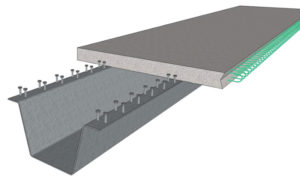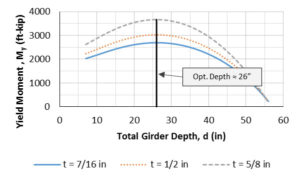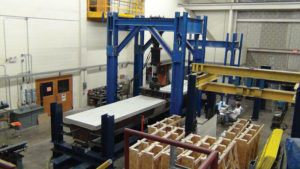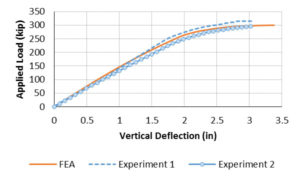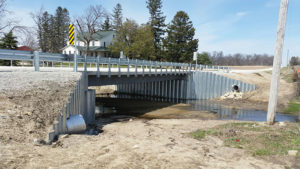The future of short span steel bridge design began in 2009 with a challenge from the Federal Highway Administration (FHWA). FHWA challenged the North American steel industry to develop a cost-effective short span steel bridge with modular components which could be placed into the mainstream and meet the needs of today’s bridge owners, including Accelerated Bridge Construction (ABC). The challenge was issued to help address the U.S. infrastructure crisis of structurally deficient and functionally obsolete bridges, nearly half of which fall in the short span category (defined as bridges under 140 feet).
To develop ideas to meet this challenge, the Short Span Steel Bridge Alliance (SSSBA) organized the Modular Steel Bridge Task Group – consisting of 30 organizations representing the SSSBA, Steel Market Development Institute, National Steel Bridge Alliance, National Association of County Engineers, steel bridge fabricators, University faculty members, steel manufacturers, government organizations, and bridge owners. The group considered many options and decided in October of 2011 that a shallow steel press-brake-formed tub girder technology – also known as folded plate girders – provided the best opportunity for meeting the FHWA goals for economics, innovation, and ABC practices.
About the Technology
The press-brake-formed tub girder system consists of modular shallow trapezoidal boxes fabricated from cold-bent structural steel plate (Figure 1). Steel shapes are available in either hot-dipped galvanized or weathering steel options. Once the plate has been formed, shear studs are then welded to the top flanges. A reinforced concrete deck is then cast on the girder in the fabrication shop and allowed to cure, becoming a composite modular unit. Modules are then longitudinally joined using Ultra-High Performance Concrete (UHPC), a relatively new class of advanced cementitious composite materials.
The system offers several advantages over traditional short span steel bridge solutions. The girder itself is incredibly simple to fabricate, requiring minimal welding. Because of the system’s modular composite design, there is a reduced need for additional details such as stiffeners or cross-frames. Also, due to the system’s modular nature, the composite unit can be easily shipped to the bridge site, allowing for accelerated construction and reduced traffic interruptions. And, while modular precast concrete decks are recommended, multiple deck options are available. Examples include the use of full-depth/partial-depth precast concrete deck panels, cast-in-place concrete decks, or more advanced composite decks such as the Sandwich Plate System (a structural composite material comprising two metal plates bonded with a polyurethane elastomer core).
Research and Development
As opposed to the cutting and welding required for typical tub girders, the system utilizes cold bending of standard mill plate widths and thicknesses for the tub girder, decreasing fabrication costs and increasing the efficiency and economic performance of steel used in the system. For each standard mill plate, a design study was performed by iterating the proportions of the girder to achieve the maximum possible flexural capacity (initially estimated to be the composite yield moment). For this study, the slope of the webs was kept at a constant 1:4 slope, the inside bend radii of the girders was maintained at a constant value of five times the plate thickness, and the top flange width was kept at a constant value of 6 inches. The concrete deck of the composite unit was at 7.5 feet wide by 8 inches thick. Normal-weight concrete was assumed, with a modular ratio of 8 and a compressive strength of 4 ksi. All plates were assumed for design purposes to have a yield stress of 50 ksi.
Figure 2 shows the results of these assessments for a sample of standard mill plates chosen for the design. From these plots, it is clear that, for each plate width and thickness, an optimum depth is seen at the point of maximum yield moment; increasing or decreasing the depth from this point results in a reduced section modulus and, therefore, a reduced yield moment. Instead of selecting an optimum depth for each plate, plates with common standard mill widths were grouped together, and an optimum depth was chosen for each group. Wider standard mill plates can be used to generate deeper girders for increased moment capacity and longer spans.
Physical flexural testing of representative specimens to verify the performance and capacity of the proposed system was conducted at West Virginia University. Testing was performed on press-brake tub girder specimens in both composite and non-composite states, beginning in the summer of 2013. The steel employed for the specimens were 84- × 7/16- × 480-inch standard mill plates of ASTM A709 Gr. 50 steel, donated by Nucor Corporation, SSAB Americas, United States Steel Corporation, and EVRAZ North America. The composite deck was cast with normal-weight concrete; results from six cylinder tests yielded an average compressive strength of 4.1 ksi.
In addition to physical testing of the press-brake-formed tub girders, assessments were conducted with three-dimensional finite element modeling using Abaqus/CAE. Element selection for these models included general purpose shells that use a reduced number of Gauss integration points (increasing the computational efficiency of the analysis) and hourglass control, which prevents zero-energy deformation modes and spurious results associated with reduced integration. The steel girders in this study were modeled using a tri-linear elastic-plastic constitutive law including strain-hardening effects. Stress-strain data for the girders was obtained from coupon testing performed at FHWA Turner-Fairbank’s Highway Research Center. Concrete was modeled utilizing a concrete damaged plasticity model available in Abaqus/CAE.
Figure 4 illustrates a comparison of the data obtained from flexural testing of two composite specimens and the results of finite element analysis. As shown, the modeling accurately captures the behavior of the proposed system. Also, the magnitude of force shown is quite noteworthy; a single modular girder is shown to be capable of resisting loads of over four times the standard AASHTO HL-93 design truck (weighing 72 kips).
Design evaluations were performed in accordance with AASHTO LRFD Specifications to assess the feasibility of the proposed system. For each girder, dead and live load force effects (i.e. moments, shears, and deflections) were computed and compared against prescribed AASHTO limits. In addition, the goal of the proposed system dictates the use of standard mill plate to fabricate the steel girder component of the modular unit. Therefore, when recommending solutions to engineers and owner agencies, preference was given to plates that are produced on a regular basis. Results of these feasibility studies yielded the following design options. It should be noted that while the system is recommended for single spans up to 60 feet in length (due to plate availability and typical press brake lengths), girders can easily be spliced for spans up to 80 feet:
- Girders utilizing 72- × ½-inch standard mill plates (applicable for spans up to 40 feet).
- Girders utilizing 96- × ½-inch standard mill plates (applicable for spans up to 60 feet).
- Girders utilizing 120- × 5/8-inch standard mill plates (applicable for spans up to 80 feet).
Also, in cases where hydraulic opening or clearance requirements dictate the use of a shallow section, the selection of a 60- × ½-inch standard mill plate may be advantageous as the resulting optimum girder design is only 12 inches deep. Also, the optimum design of a 60- × ½-inch standard mill plate girder results in an out-to-out width less than half of the 7.5 feet wide concrete deck (a common upper limit for shipping considerations), meaning two steel girders can be placed along a single composite concrete deck. The resulting “twin girder” composite girder is applicable for spans up to 65 feet.
The initial testing was completed in 2014. Additional testing is being conducted this year to further evaluate the performance of the longitudinal UHPC closure pour and to provide fatigue testing of galvanized and non-galvanized girders.
From the Laboratory to the Construction Site
Brian Keierleber, P.E., Chief Engineer of the Secondary Roads Department of Buchanan County, Iowa, was awarded a grant from FHWA Innovative Bridge Research and Development Program (IBRD) to replace the Amish Sawmill Bridge at 1358 Dillon Avenue in Fairbank, Iowa. The $350,000 IBRD grant was awarded on the basis of using a “bent steel plate girder section supported on Geosynthetic Reinforced Soil (GRS),” laying the groundwork to complete the first installation of the proposed modular press-brake-formed steel tub girder system in the United States.
Construction on the Amish Sawmill Bridge began in the late summer of 2015 and was finished in December 2015 (Figure 5), completing the journey from concept to implementation in under three years, a remarkable feat in the field of bridge engineering. Local contractors were presented with different composite deck options for the bridge; the winning bid elected to utilize a cast-in-place option. This bridge was not constructed by a local crew since it was federally funded, but it could have been since it was standard bridge construction and no special expertise was required. The bridge was dedicated on January 8, 2016, with a ribbon-cutting ceremony featuring several government and transportation officials. Researchers from West Virginia University, Marshall University, and the University of Wyoming are continuing field performance monitoring on the bridge.
Transforming Short Span Steel Bridge Design
Several state Departments of Transportation have expressed interest in building press-brake-formed steel tub girder bridges in their jurisdictions. Currently, two additional press-brake-formed tub girder bridges are scheduled for construction in West Virginia within the next year. Also, the Ohio Department of Transportation and Muskingum County, Ohio, were awarded an FHWA Accelerated Innovation Deployment (AID) grant to replace a bridge on County Road 7 – Cannelville Road. The $557,600 AID grant will be used to install a press-brake-formed steel tub girder system with a Sandwich Plate System deck.
The technology is appealing because it offers significant cost savings, ease of shipment and fabrication, accelerated construction, design versatility, and sustainability. Steel is the world’s most recycled material and, at the end of the bridge’s life, it may be transformed into another steel product. With so many benefits, press-brake-formed steel tub girders provide the potential for widespread use in helping to solve America’s critical infrastructure challenges.▪

